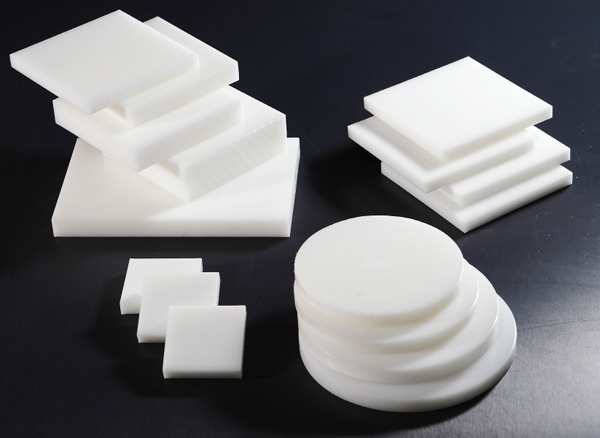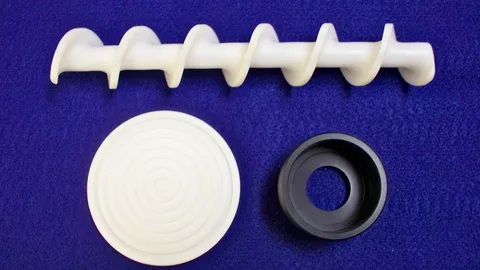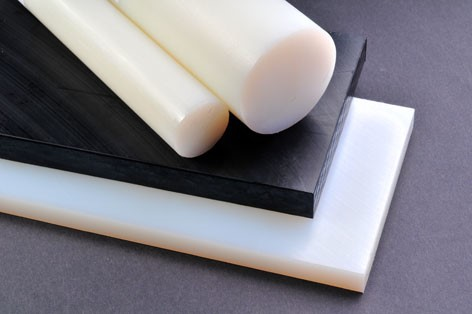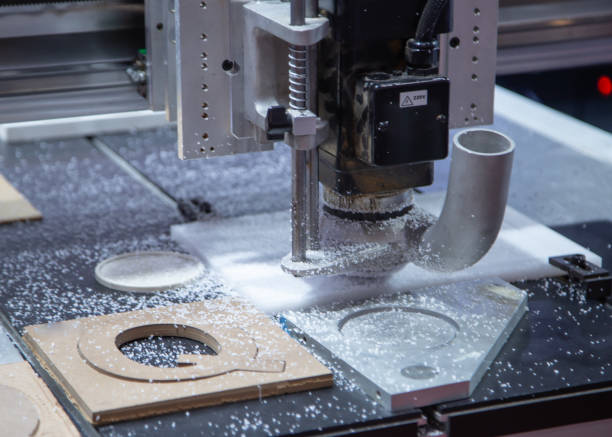For projects that require materials with a low coefficient of friction, tensile strength, and rigidity, look no further than Acetal and Delrin.
Both materials have unique properties, but for specific applications, you need to know the difference between Acetal and Delrin to use them correctly. This article will talk about the their comparison while showing everything you need to know about them.
Overview of Acetal

Acetal polymer or POM is a plastic material incorporating several monomers in the repeating CH2O units. Also known as polyacetal, polyformaldehyde, or polymethylene glycol, acetal behaves like metals. Hence it can replace some metals in plastic machining and other manufacturing processes.
Properties of Acetal
Generally, whether copolymer or homopolymer, acetal plastics have the following properties.
- Recyclable as it liquefies at about 1620C to 1750C
- Excellent heat resistance
- Great electrical resistivity
- Low water absorption
- Low coefficient of friction
- High strength and rigidity
Types of Acetal
There are two general types of acetal, each with its inherent properties copolymer acetal (POM-C) and homopolymer acetal (POM-H).
On the one hand, POM copolymers contain different monomeric units in the repeating CH2O units. They have excellent dimensional stability and chemical and abrasion resistance and are important in injection molding and plastic extrusion. They also have a wide color variation such as black, blue, red, green, and brown. Trade name includes Celcon®, Duracon®, Hostaform®, Tepcon®, and Ultraform®
Acetal homopolymer under the major trade name Delrin® does not alter the repeating CH2O units and will be discussed fully below. There are also acetals with both homopolymer and copolymer characteristics, e.g., Acetron®, Kepital® POM, Sustarin® C, Tecaform®, Tenac™-C
Overview of Delrin

Delrin plastic is the tradename for acetal homopolymer produced by DuPont. It has recurring CH2O units, which can be elongated and shortened to form different products. It is a common plastic in plastic machining due to its tensile strength and injection molding due to its high flow rates leaving aside its other properties.
Properties of Delrin
Compared to acetal copolymer, Delrin has better mechanical properties. However, it also lacks a few other things. Below are the properties of Delrin.
- A low-density center or center line porosity
- Be hemical resistant
- Great stiffness and higher flexural modulus at room and elevated temperature
- High tensile and impact strength
- Hard with a low coefficient of friction
- High creep resistance
- High flow rate
- Recyclable
- High electrical resistivity
Grades of Delrin
Due to its tweakable to form different products without losing its homopolymer form, there are many grades of Delrin. Each grade has unique properties and applications. Below are common grades that could be useful for your project.
- Delrin 150: Delrin 150 has the best mechanical properties among the other acetals. It has exceptional strength and rigidity with resistance to warpage at high temperatures. It also has high lubricity making it resistant to wear and tear, hence its long-term use.
- Delrin AF 100 (13% PTFE Filled): Delrin AF 100 is durable, wear-resistant, and has natural lubricity. The material becomes stronger and more durable with the addition of PTFE (polytetrafluorethylene).
- Delrin (30% Glass Filled): Glass-filled Delrin has unequal impact resistance and is the right grade of Delrin for making products subjected to constant stress.
- Delrin AF DE588: Delrin AF DE588 contains 20% PTFE fibers, giving it better rigidity, strength, and durability. It is an important material in the Navy applicable in making submarine parts.
All the grades of Delrin are highly machinable, making them the perfect material for some projects. The material properties make it a substitute for other machining materials in rapid prototyping. For example, the Delrin vs nylon comparison shows the comparability of the two materials.
Is Delrin the Same as Acetal?
No, Delrin is different from acetal. Acetal is polyoxymethylene (POM), a class of semi-crystalline plastics prevalent in plastic machining. Delrin is the tradename for acetal homopolymer having constant repeating CH2O units. This shows the acetal plastic vs Delrin comparison is baseless, and it should be more of the acetal copolymer vs Delrin. Acetal copolymer is POM with substituted monomeric unit alongside the CH2O units.
Even though they belong to the same family, their properties are different. For example, Delrin has a higher tensile strength than acetal. It is thinner, making it the perfect material of the two for making small/thin structural models.
What Are the Differences Between Acetal Copolymer and Delrin?

Delrin and other acetal copolymers belong to the same family. Hence their uniqueness even though they have different advantages and applications. Below are the differences between both materials.
· Composition
On the one hand, Delrin is a homopolymer as it maintains these repeating units with end caps. On the other hand, acetal copolymer adds other monomers at different chains every 70-100 units.
As a result, the molecular differences affect the crystalline nature of both materials. Here, Delrin has a large crystalline structure due to the organized slacking of the polymer, whereas the copolymer disrupts such organization.
· Hardness
The difference in hardness in the Delrin vs acetal comparison is not elaborate. Yet, it matters. Delrin has a hardness of 86 Shore D while POM copolymers have a hardness of 85 Shore D. Therefore, Delrin will be more resistant to impacts and abrasion. Also, it will have a lower coefficient of friction. Therefore, it will be able to slide over other parts easily.
· Chemical Resistance
Acetal copolymers are more resistant to hot water and strong caustic solutions with a higher pH value than Delrin. Therefore, they are better for making parts used in such conditions. Nevertheless, Delrin is also chemical resistant and unaffected by fungi, insects, or other organisms.
· Temperature Tolerance
Delrin has a higher temperature tolerance than acetal, with an operating temperature range of (-40 °C to 120 °C). It does not become brittle at low temperatures and has high impact resistance. Yet, it can still withstand a peak temperature of 1750C.
Copolymers have a high operating temperature range of 100°C. Nevertheless, for short-term purposes, they can work at about 1400C.
Both materials are unsuitable for high-temperature applications.
· Flexural Yield Strength and Tensile Strength
Flexural yield and tensile strength are other important points to look out for when comparing acetal vs Delrin. Delrin has a yield strength of 11,000psi, while acetal has a yield strength of 9,500psi. Also, Delrin has a tensile strength of 13,000, while acetal has 12,000. This shows that both materials are strong and suitable for making structural models. However, Delrin is stronger, making it more suitable for making parts with structural applications.
· Porosity
Delrin has a lower-density or porous center, which lets it contain small bubbles or voids. Therefore, gases and liquids can seep into the material. Copolymers are not porous. Therefore, they are more suitable for making parts where porosity is frowned on, for example, in the food and medical industries.
· Application
Both materials have many industrial and mechanical applications. However, their properties have a limitation. Delrin is more suitable for parts that require a strong POM material, while acetal is more suitable for those that require a chemically resistant POM material.
Both materials are applicable in injection molding, plastic machining, 3D printing, for making gears, bearings, bushings, rollers, fittings, electrical insulators, and other parts used in the automotive, construction, consumer goods, electrical, food processing, and packaging industries.
· Cost
POM materials are very cheap, with common copolymers costing within the range of $1500 to 2500 per ton. However, Delrin is more expensive than the others due to the branding and the better mechanical properties it possesses.
Acetal vs Delrin: When to Choose Between Them

Based on the properties of both materials, you should be able to guess when to choose either. Below are when to use both materials. in rapid prototyping.
· Heavy Loads
Both materials have high tensile strength and yield strength. However, Delrin is the better choice for making parts that apply constant heavy load over long periods due to its higher tensile and yield strength. Also, it would be best if you chose Delrin grade when working with parts exposed to repeated impact.
· Friction
Delrin has a lower coefficient of friction. Therefore, it is the better option when making parts that undergo back-and-forth or rotating sliding motion against another metal or plastic. When used, there is no need for lubrication.
· Dimensional Stability and Lightweight
When it comes to dimensional stability and lightweight, consider using acetal copolymers. They have a crystalline structure that reduces the dimensional stability, and the plastic material disrupts the organization of a large crystalline structure by not conforming to an organized slacking of the polymer.
· Chemical Resistance
This is a major distinction in the acetal vs Delrin comparison. Use acetal here as they are less susceptible to acidic or basic chemicals. The high resistance to chemicals will ensure that the part is not susceptible to industrial solvents, lubricants, agricultural.
· Temperature and Flammability
Avoid using both types of plastics in making parts that you will expose to long-term temperatures greater than 90°C. Also, avoid long-term immersion in hot water (>60°C). Besides, both materials are highly flammable and should not be used in applications requiring flammability ratings above HB.
Manufacture Plastic Parts With Low Cost and Short Lead Time
So, want to outsource your plastic parts? RapidDirect that offers injection molding services, CNC machining services and 3D printing services is yours. We are ISO 9001:2015 certified company with strategic and creative experts that deliver the best affordable service using our automated machines.
We have an online quotation platform that provides a real-time quotation and free DFM analysis. You can adjust the number of parts, materials, and surface finish you need. Upload your design file today and get a quote and DfM analysis within 12 hours.
FAQs
POM plastics are general-purpose semi-crystalline engineering thermoplastics known for their organized molecular structure and sharp melting points. There are two major types of POM: homopolymer (Delrin) and copolymer (other types of acetals), each having unique properties.
POM is resistant to heat until the temperature reaches its melting point, where it liquefies and becomes moldable. Being a thermoplastics, it is an important material for injection molding. It is also applicable in CNC machining due to its high machinability
No, Nylon is stronger than Delrin (Extruded nylon = 12,400PSI while cast nylon = 13500 PSI). Nevertheless, their similar properties provide overlap in industry applications. This is evident in their use in making parts such as bearings, gaskets, gears, rollers, and washers.
Polycarbonate is the strongest plastic on the market. The unique plastic is 200 times stronger than glass and has high impact resistance. Hence it doesn’t break or crack. Therefore, it is applicable alongside Delrin in making structural parts.


